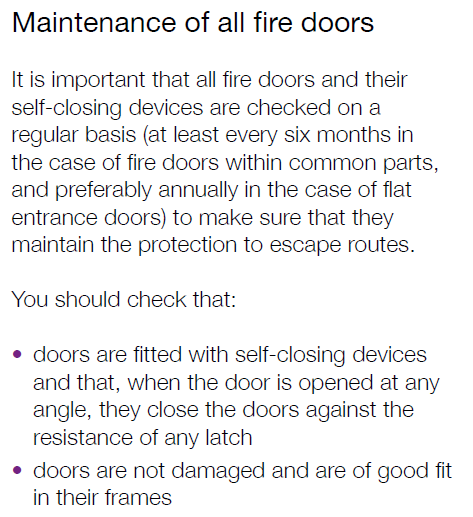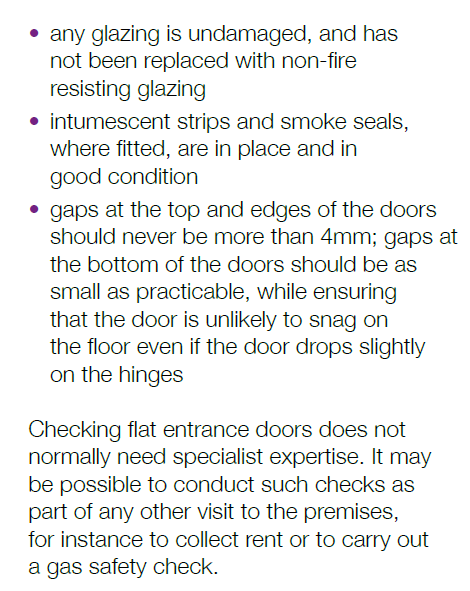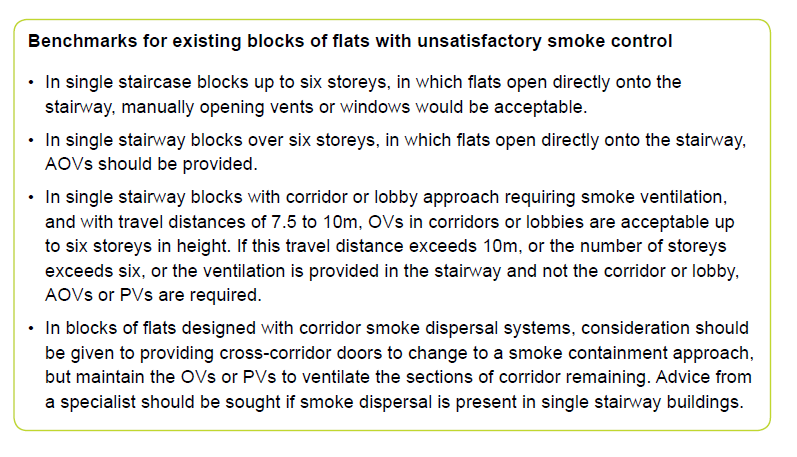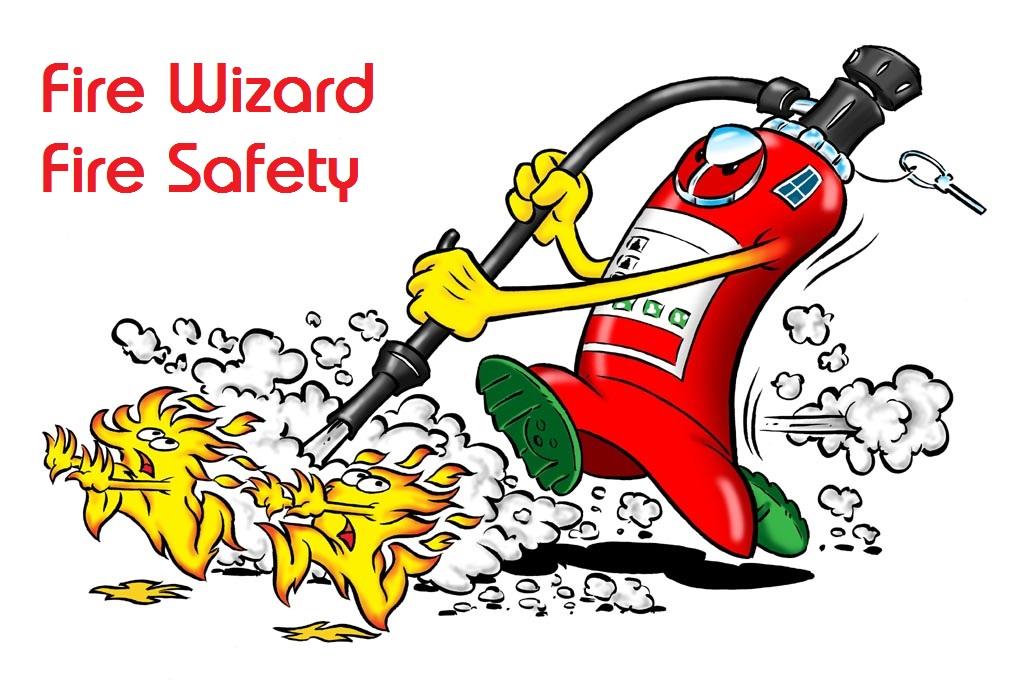-
Posts
2,621 -
Joined
-
Last visited
Posts posted by AnthonyB
-
-
Possibly, especially if they are a workplace used by care staff on the premises. Other legislation can apply covering fire safety and most responsible providers carry out some form of FRA including person centered FRAs
See here for detailed guidance
https://www.nifrs.org/wp-content/uploads/2021/02/NFCC-Specialised-Housing-Guidance.pdf
-
See above answer - the building includes two or more dwellings with an external wall in common so yes it does.
-
On 18/09/2024 at 19:30, Ian London said:
A quick question about Anthony's comment here before I go back to our Property Manager.
How long is a Fire Risk Assessment valid for? e.g. should we have one done every year, the same as the fire doors should be checked?
And should the person carrying it out have qualifications / certification?
A fire risk assessment must be reviewed by the responsible person regularly so as to keep it up to date - the interval is not set in legislation but usually expected to be annually - a full new assessment isn't required unless there is reason to think the existing one is invalid or there has been a significant change in the matters to which it relates including when the premises, special, technical and organisational measures, or organisation of the work undergo significant changes, extensions, or conversions.
Some Responsible Persons will have their external competent provider re-assess annually, others will review themselves in house and only reassess if there are changes or 3-5 years have passed. Both can be seen to be valid approaches & I have clients that work in both of the above - some bring me in annually, others every 2-3 years. -
Dust Box?????
-
-
The law says the FRA must cover the external walls. An EWS1 is nothing to do with fire safety legislation and is a tool for lenders. Where a site is low rise and low risk the FRA can address it without the need for an (expensive) PAS9980 External Walls Fire Risk Appraisal - mine do as do other providers I've worked for or provide verification for.
Sadly there are too many in the FRA sector that don't really know the ins and outs of residential fire risk assessment - so many either require completely unnecessary work or dangerously miss out key areas.
For the pictured block roof void access would also be needed if possible to check the fire walls in the void - too many assessors miss this even though the government guidance considers it a standard part of all residential FRAs -
Will the cables remain mechanically fixed to the wall or ceiling by metal fixings after the PVC trunking has melted and failed? If so, then yes. If the cable is only clipped to the trunking and will sag & fall with it then no.
-
If they don't have a way leave to access the land then it can be obstructed - it's a civil matter and you should take legal advice from a property law specialist.
-
That's one for your Fire Risk Assessor to deal with. The FRA would look at occupancy numbers, layout, travel distances, other fire precautions etc and determine if the building can comply & remain safe without it. I've assessed various buildings with this situation and some have been able to do without the stair but others have had to replace it.
Many standards are not retrospective and age alone doesn't mean it's unsuitable, why exactly have you been told to replace it - most often it's due to lack of maintenance and becoming structurally unsound being the reason to replace - again your fire risk assessment should take a pragmatic approach as to whether an older style stair is suitable. -
No - as it is a building containing two or more dwellings it is subject to the Fire Safety Order & whilst there are no internal common areas the Fire Safety Act 2021 clarifies that the FSO applies to the structure, external walls (including balconies, doors and windows) & flat entrance doors. The FRA would only cover the outside of the building and based on the photos would most likely conclude the risk is low, but would still be required.
-
Also if the fire service decide you need to evacuate they will tell you where to assemble, which could be any number of places as evacuation of a stay out block would be the result of a dynamic risk assessment and your location could be affected by the nature of the building failure, fire and weather conditions, layout & distribution of emergency vehicles and operations, etc
-
In the UK, the word "shall" is used in legal documents to indicate a requirement that is binding and must be implemented. It is a modal verb, which is a verb used to express an obligation. So I'd put a standard triangle key meter cupboard lock on or a T-bar lock and distribute keys.
For the protective coatings and test data I'd suggest visiting https://envirograf.com/ & https://thermoguard.uk/
-
Approved Document B is not a regulation, it is just one way of meeting the rather broad functional requirements of the Building Regulations and is not a mandatory document - you can use other methods:
"The fire safety requirements of the Building Regulations will probably be satisfied by following the relevant guidance in this approved document. However, approved documents provide guidance for some common building situations, and there may be alternative methods of complying with the Building Regulation requirements. If alternative methods are adopted, the overall level of safety should not be lower than the approved document provides. It is the responsibility of those undertaking the work to demonstrate compliance."As what the fire engineer proposed is along the lines of what is often accepted I would suggest you request a determination:
https://www.gov.uk/guidance/building-regulations-determinations
-
If you can apply BS9999 in general as a solution to the premises the fire alarm would give you an extra 15% in travel distances and 15% less door width required & the ceiling height an extra 27% TD & 27% less width subject to the maximums in Table 15 which would give you 24m TD and 3.3mm per person door width if risk profiling and as an existing building I'd argue the PAS79 principles for risk assessment would tolerate the extra metre - this wouldn't account for the travel within the offices however as a heritage building a bit of common sense should apply - whilst the library could be deemed a high fire loading what is actually going to be the ignition risk and what is going to the fuel for a primary fire large enough and long burning enough to ignite the tightly packed books.
If the premises don't meet BS9999 enough such that the above relaxations are 'cherry picking' from it you are back at square 1 and it's time for a fire engineer and modelling. -
What are the occupancy numbers for the rooms, how high is the ceiling of the main library room & what category of AFD is there?
-
I think it's a custom key and the panel is discontinued. There is no code override to use instead of the key and the Profyre & Profyre MKII protocols are obsolete too so they don't make a newer version, just a different one running System Sensor protocol.
Shorting out the key to leave it in access level seems the only option for an engineer save replacing the lot (new panel, call points, detectors and sounders)Manuals:
https://manualzz.com/doc/7332026/profyre-a2-user-manual?p=20
-
On 31/08/2024 at 12:07, Ian London said:
Thanks for your replies everyone.
I have a few specific questions.
1. Routine checking of fire doors
In the document that Mike North linked to above, item 2.3 states that "regulation 10 applies to all blocks of flats that incorporate common parts", but in 2.4 states that regulation 10's routine fire door checks (flat entrance doors every 12 months and communal doors every 3 months) "are only required in blocks of flats in which the top storey is more than 11m above ground level (typically, a building of more than four storeys)".
So, as our blocks are under 11 metres, does this mean that we don't need to have routine fire door checks?
2. Self-closers
When are concealed door closers compliant? Our flat entrance doors all have concealed self-closers fitted. Most of them need to be replaced as they aren't strong enough to fully close the doors anymore.
Is it correct that new concealed closers are compliant when fitted as replacements to existing notional fire doors? But not compliant to be fitted to new fire doors — new doors can only have overhead self-closers?
In section 6 of the same document linked to above, photo 5 shows a concealed self-closer (the same type that we currently have fitted) — this photo implies that concealed self-closers are compliant?
3. Electrical riser cupboard doors
Our previous managing agent, who told us that they had met with the Head of Building Control of the local council and “agreed the requirements for the upgrade of notional doors”, commissioned the upgrade of our electrical riser cupboard doors whereby intumescent strips were fitted and the thickness of the doors were increased (see photo below).
In the recent survey, these doors were failed for the following reasons: "Door has had 6mm GypRoc applied to rear face to increase thickness from 40mm to 46mm. Fixed to rear face using drywall screws. Replace door to current regulations."
Who is correct? Our previous managing agent led us to believe that the upgrades they had done brought the doors up to current regulations. If this is not the case, it's frustrating as it means we are paying twice for the same thing.
Thanks for your help
Ian
1. Routine Checking of Fire Doors. Regulation 10 of the Fire Safety (England) Regulations does not override the inspection & maintenance regime required under Article 17 of the Fire Safety Order, it just sets a mandatory minimum interval between checks for taller buildings. For smaller blocks the HM Govt guidance is:


2. Concealed single chain uncontrolled non adjustable concealed closers (often called 'Perko's' after the original manufacturer's brand name Perkomatic) have been frowned upon since the 90's and positively discouraged since the 2000's due to issues in performance and long term reliability, but (as usual as evidenced by Phase 2 of the Grenfell Report) HM Govt shied away from explicitly disallowing them on existing buildings, happy that there non compliance with EN1154 stopped them being used on newer builds - only rising butt hinges are specifically disallowed. So as long as the closer shuts the door fully flush in frame overriding any latches it is acceptable in an older building under Article 50 guidance, which means you can't be held in breach. If they are no longer effective then they will require replacement with a modern closer (often to avoid damaging the door/leaving a hole the Perko is left in place with the chain cut and an overhead closer fitted)
3. Upgraded door. The door upgrade method you have shown has been used for decades under the Fire Precautions Act and HMO Guidance and even has some test evidence behind it and will enhance the performance of the door. It's not possible to say you are guaranteed to get the full 30 minutes of a certified new door, but subject to risk assessment it's acceptable and as I've previously answered current HMG guidance will accept older and upgraded doors in smaller blocks so you would not be in breach.
Unfortunately fire doors became big business after Grenfell and dozens of companies have jumped on the bandwagon with many only having staff that can do a pass/fail inspection against a new door standard rather than work holistically in conjunction with the fire risk assessor -
I've answered this in another forum for you - in essence yes, but for larger areas than you are covering it is cautioned against using a small number of very high or a large number of very low rated units.
A 661 sq.m. building would have a floor rating of 43A. A single 43A rated powder or high performance water additive would meet this as would 9 x 5A rated Powders but for the best balance of individual unit fire fighting performance and distance of travel to get to the extinguisher (without putting the fire between you and the exit) you might be better with 4 x 13A units.
They don't all have to be the same - you could also use 2 x 21A rated units and an 8A rated unit, the combinations can be endless the larger the area! -
On 30/08/2024 at 13:42, Hayfever said:
I note that the 2litre Triclass P50s (as mentioned above) have been discontinued and the former 13A and 55B is now replaced by a 2litre water mist with an 8A, 5F rating
That's not much of an alternative is it as you now need to buy 2 units to get the same rating???
Do I take it the change is for environmental protection reasons? (The effects of foam to the environment?)Yes - Fluorine free foams are available, but they require a different method of delivery using a large aspirating nozzle instead of a small non aspirating spray nozzle which would require extensive redesign of the 2L valve to fit, plus it's not clear if it would still achieve the high ratings.
6 & 9L P50 foams still exist but not a 2L unless sufficient demand to remodel the design to accommodate F3 foam exists.
I feel your pain - I used the 2L a lot in building change overs as it was very costs effective. -
9 hours ago, Guest JMF said:
Do we require a fire door in a portacabin . door comes from a office into the only corridor
Not normally - the travel distances in single cabins don't require protected routes and they are too small to require compartmentation
-
It's not uncommon in situations like this for residential sprinklers to form part of a solution as well as stove guard auto cut outs - it does depend on the size of the premises & layout. I've also seen smoke control (Automatic Opening Vents) used inside dwellings to compensate as well. You would be best consulting with a Fire Engineer
-
You shouldn't need to ask this as you should have a Fire Risk Assessment in place that has answered this for you - as the Responsible Person I'd recommend the Resident's Management Company instruct it as some agents will use the cheapest provider and you usually end up with an FRA that either misses critical areas & puts you at risk or is OTT and costs you thousands in unnecessary work. I was asked to do an FRA by an RMC after their agent said they needed to spend tens of thousands on a fire alarm and ne doors - in reality all they needed to do was change a couple of windows so they could be used as openable vents for smoke control.
For example in your case your doors are most likely to only need repair if they are in essence the original '86 fire doors (notional doors as below).

-
No - It is your legal responsibility if carrying out a change of use or alteration subject to Building Regulations to demonstrate how the work will comply with the fire safety aspects of the Regulations.
Even where the Building Regulations aren't involved it is your responsibility to have completed Fire Risk Assessments and implemented general fire precautions based on that assessment, the Fire Service's role is to enforce, not tell you what to do as that's what your Fire Risk Assessment is for.
None of these requirements are new, they are principles that have existed for decades, it's just that as a small premises it will have escaped scrutiny in the past and it's caught up with you unfortunately. In essence you are looking at structural fire protection - such as fire resistant glazing next to external stairs, underdrawing of the floors with fire resistant boarding to either 30 minutes or 60 minutes depending on the use of the upper floors and enclosing the stair in fire resisting construction and terminating it in a final exit door to the outside or a protected corridor to an existing exit.
The fact this has only been brought up after you have completed your conversion implies you haven't gone through the Planning Permission & Building Control Approval that would be required for the change from from use class E to “sui generis” because if you had this should have been raised well before you completed the works.
https://www.gov.uk/government/publications/people-with-duties-under-fire-safety-laws
-
It depends on the risk- the guidance is reasonably proportionate in retrospective requirements:




Leaseholder run management company refusing to share Fire safety report
in Fire Risk Assessments
Posted
It's a legal requirement for them to share relevant details under s156 of the Building Safety Act
Provision of information to residents
The amendments made to the Fire Safety Order should make people feel safer in their homes and ensure that residents understand what you are doing to comply with your responsibilities. We have already mandated specific instructions that you must provide to your residents under the Fire Safety (England) Regulations 2022, but these new requirements go further to enhance the provision of information and help residents feel informed and involved. It is also important that you record your name and a UK address in the fire risk assessment to make it easier for enforcement authorities to identify you and, where necessary, take enforcement action.
You must provide residents with the following information:
any risks to residents identified in the fire risk assessment
the fire safety measures provided for the safety of any or all occupants (such as the means of escape, the measures to restrict the spread of fire and what people should do in the event of a fire)
the name and UK address of the Responsible Person
the identity of any person appointed to assist with making or reviewing the fire risk assessment
the identity of any competent person nominated by the Responsible Person to implement firefighting measures
any risks to relevant persons throughout the building that have been identified by other Responsible Persons in the building
You should consider providing contact details, if different to your contact details as the Responsible Person, for residents to be able to inform you of any concerns or queries they have about fire safety matters, or the information provided to them.
Government may, by regulation, update the list of information to be provided to residents to reflect future developments in fire safety and specify the frequency and format in which the information should be provided.
The Fire Safety (England) Regulations 2022 already mandate fire safety instructions that must be shared with residents of multi-occupied domestic premises where resident evacuation would be through common parts, such as the evacuation strategy, how to report a fire and what they must do when a fire occurs. In addition, the Regulations require Responsible Persons to provide information on fire doors including that they should be kept shut when not in use, that residents should not tamper with self-closing devices and that residents should report any faults with doors immediately. The Regulations stipulate that information on fire safety instructions should be displayed in a conspicuous part of the building with a copy provided to new residents when they move in and existing residents on an annual basis.
If you are the Responsible Person for a building located in England, you should provide both the instructions required under the Regulations and the information required as a result of the changes to the Fire Safety Order. Under the Building Safety Act 2022, Accountable Persons also have responsibilities to share information with residents. It may be helpful to cooperate with Accountable Persons to provide all sets of information as a single package so that all necessary information is in one place and format for residents.
You can find the requirements contained within the Fire Safety (England) Regulations 2022 here.